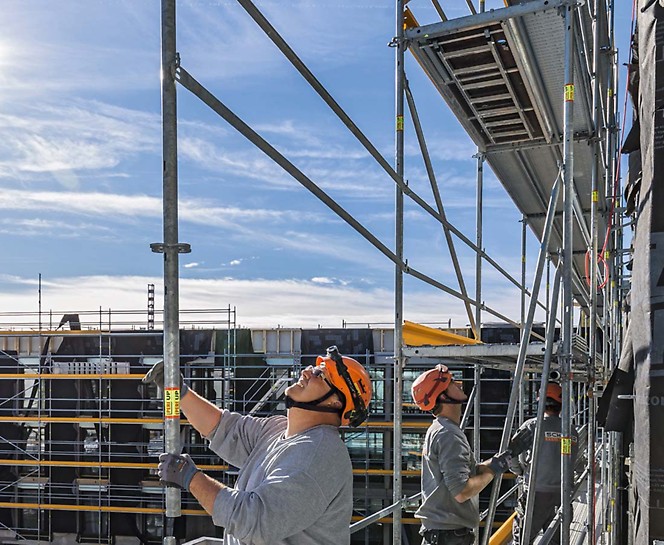Discovering the Different Sorts Of Scaffolding Made Use Of in Building And Construction Projects
The construction market counts heavily on various types of scaffolding to fulfill certain job needs, each offering distinctive benefits and applications. Traditional structure scaffolding supplies a sturdy foundation for basic tasks, while put on hold scaffolding is vital for job on high-rise structures.

Traditional Frame Scaffolding
Conventional framework scaffolding is one of the most commonly made use of techniques in the building and construction market due to its robustness and flexibility. This system contains horizontal and vertical frameworks that are assembled to develop a stable platform for workers and materials. The main elements include upright articles, straight journals, and diagonal dental braces, which together supply a solid structure that can sustain significant loads.
Among the essential advantages of traditional framework scaffolding is its adaptability to numerous building tasks, ranging from domestic buildings to big industrial structures. The modular design permits for simple setting up and disassembly, making it reliable for both lasting and short-term projects. In addition, the system can be tailored in elevation and size, accommodating various building designs and site problems.
Security is paramount in scaffolding applications, and traditional frame systems are furnished with guardrails and toe boards to avoid falls and guarantee employee protection. In addition, normal examinations and adherence to safety regulations are crucial in maintaining the honesty of the scaffold. Overall, conventional structure scaffolding stays a fundamental choice in the construction industry, supplying a dependable system for labor and enhancing total project effectiveness

Suspended Scaffolding
Suspended scaffolding uses a distinct solution for building and construction projects that need access to raised surface areas, especially in scenarios where conventional framework scaffolding might be not practical. This sort of scaffolding is commonly suspended from the roofing or top levels of a framework, using a system of pulleys, ropes, and platforms to produce a working space that can be gotten used to various heights.
One of the primary benefits of suspended scaffolding is its adaptability. It can be easily repositioned or lowered to fit modifications in building and construction needs, making it excellent for tasks such as window installation, frontage job, and upkeep on skyscraper buildings. Additionally, the marginal footprint of put on hold scaffolding enables far better use ground area in metropolitan settings, where room is usually limited.
Safety is a crucial consideration in the use of suspended scaffolding. Generally, suspended scaffolding provides a effective and efficient remedy for accessing hard-to-reach locations in different building and construction scenarios, enhancing both performance and safety and security on website.
System Scaffolding
System scaffolding, typically considered a contemporary service in the scaffolding market, contains pre-engineered parts Your Domain Name that can be promptly assembled and adjusted for various building projects. Scaffolding. This kind of scaffolding is defined by its modular style, which enables adaptability and effectiveness on work sites, accommodating structural needs and various elevations
Usually made from high-strength steel or aluminum, system scaffolding uses boosted toughness and stability. The components include upright posts, straight ledgers, and angled braces, which interconnect safely, making sure a durable framework. The design frequently integrates standard fittings, simplifying assembly and disassembly procedures, thereby minimizing labor time and costs.

Rolling Scaffolding
Rolling scaffolding is a functional option to conventional fixed scaffolding, designed for mobility and ease of usage on construction sites. This kind of scaffolding includes a system sustained by frameworks with wheels, allowing workers to easily relocate it as needed. The mobility feature substantially enhances productivity, as it reduces downtime connected find more info with disassembling and constructing repaired scaffolding.
Commonly built from light-weight materials such as light weight aluminum or steel, rolling scaffolding provides a durable yet mobile service for jobs calling for constant repositioning - Scaffolding. It is particularly useful in jobs such as paint, drywall installation, and electric work, where accessibility to different elevations and places is necessary
Safety and security is vital in rolling scaffolding style, with attributes such as securing wheels to stop unplanned motion when in usage, and guardrails to safeguard workers from falls. Additionally, several designs are flexible in elevation, fitting different job requirements.
Cantilever Scaffolding

The design of cantilever scaffolding commonly entails making use of braces or arms anchored to a building or structure, enabling the system to prolong outside securely. Security is vital; therefore, these scaffolds need to be crafted to stand up to ecological conditions and various lots. Regular assessment and upkeep are important to make certain structural honesty and employee safety and security.
Cantilever scaffolding is favored for its flexibility and effective usage of room, making it a preferred selection in city settings where space restrictions prevail. It helps with easier accessibility to high altitudes, eventually adding to the total performance of building and construction jobs. As with all scaffolding kinds, proper training and adherence to security standards are vital for employees utilizing cantilever scaffolding.
Conclusion
Traditional frame scaffolding gives security, while suspended scaffolding uses versatility for elevated tasks. System scaffolding facilitates quick assembly, and rolling scaffolding improves wheelchair for differing work settings.
Traditional frame scaffolding provides a sturdy structure for basic jobs, while put on hold scaffolding is necessary for job on skyscraper frameworks.Moving scaffolding is a flexible option to conventional set scaffolding, designed for mobility and convenience of usage on building sites. As with all scaffolding types, appropriate training and adherence to safety requirements are essential for workers making use of cantilever scaffolding.
Conventional frame scaffolding gives stability, while suspended scaffolding provides flexibility for raised jobs. System scaffolding assists in fast setting up, and rolling scaffolding boosts wheelchair for varying work settings.
 Mackenzie Rosman Then & Now!
Mackenzie Rosman Then & Now! David Faustino Then & Now!
David Faustino Then & Now! James Van Der Beek Then & Now!
James Van Der Beek Then & Now! Tyra Banks Then & Now!
Tyra Banks Then & Now! Pauley Perrette Then & Now!
Pauley Perrette Then & Now!